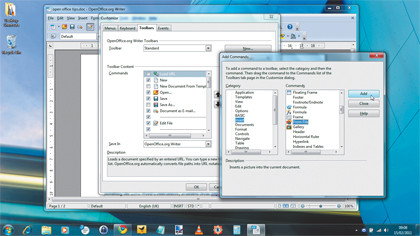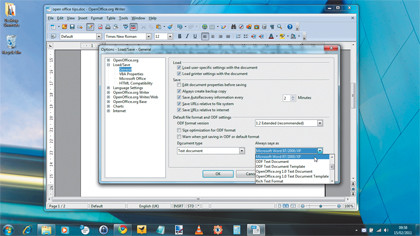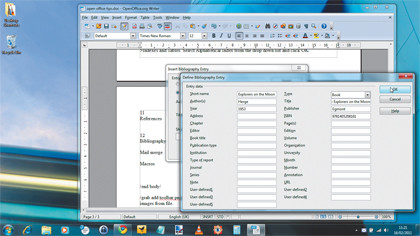Tutorial: Get OpenOffice working the way you want with these tips - If you who haven't used OpenOffice.org yet you are missing out, and so is your wallet. it's packed with features and works well with documents created in Microsoft Office. If you're wavering then there's one other factor to consider: OpenOffice.org is free, so just give it a try!
To help you along, we've put together 12 tips that will help you get the most from Writer, its word processor.
1. Add content to toolbar
If you're used to Microsoft Office then you might find OpenOffice.org's menu system a little unfamiliar and jarring. The experience may leave you hankering after the Ribbon, but you can make Writer much easier to use by ensuring that your favourite tools appear on the standard toolbar.
Choose 'View | Toolbars | Customize' and select the toolbar you want to modify. There's generally room for a few more functions on the standard one. You can simply tick or clear any of the boxes next to each of the commands to add or remove them.
To help you along, we've put together 12 tips that will help you get the most from Writer, its word processor.
1. Add content to toolbar
If you're used to Microsoft Office then you might find OpenOffice.org's menu system a little unfamiliar and jarring. The experience may leave you hankering after the Ribbon, but you can make Writer much easier to use by ensuring that your favourite tools appear on the standard toolbar.
Choose 'View | Toolbars | Customize' and select the toolbar you want to modify. There's generally room for a few more functions on the standard one. You can simply tick or clear any of the boxes next to each of the commands to add or remove them.

To add one not already in the list, click 'Add'. You can now browse through all the available menus to find the command you want. Select it and click 'Add'.
2. Rearrange the toolbar
You can move items around within a toolbar to make them suit the positioning you're used to, or just to make them easier to find.
Select 'View | Toolbars | Customize' and pick the toolbar you want to work with, which in most cases will be the standard one. Highlight the item you want to move and use the up and down arrows to change its position in the toolbar.
If you don't like the name of a particular tool, select it, choose 'Modify | Rename' and enter the name you want to use. Don't like the icon? Choose 'Modify' again and select 'Change icon'. Pick from the list of icons or click 'Import' and use your own custom file.
3. Keep a running word count
Word users who are new to OpenOffice.org often miss the running word count in the status bar. This feature was present in Word 2007 onwards. You can get a word count of a highlighted section by choosing 'Tools | Word Count', but it lacks the immediacy of the Word feature.
You can fix this by installing the Live Word Count macro from this link. Download the file and move it to 'C:\Users\[username]\AppData\Roaming\OpenOffice.org\3\user\Scripts\python', making the 'python' folder if it isn't already there.
Test the macro by choosing 'Tools | Macro | Run macro'. Now expand 'My Macros' and select 'wc', followed by 'wordCount'. Click 'Run'. You'll get a floating window showing the total words, which changes to show the total for any selected area.
For easy access, add it to the toolbar. Choose 'View | Toolbars | Customize | Add'. Under 'Add commands', scroll down to 'OpenOffice.org Macros' and expand it, then go to 'My Macros | wc | wordCount'. Click 'Add' and position it in the toolbar.
4. Set default save options
OpenOffice.org is fully compatible with Microsoft Office file formats and can open any file, including those in the newer DOCX format. Two compatibility issues tend to put users off OpenOffice.org, though.

Firstly, in documents that use complex layouts in Word, some positioning of page elements can change in Writer. Secondly, the default save format is Open Document Format, which stymies some Microsoft Office users if their systems aren't up to date, including all import filters.
However, it's easy to fix this and ensure that Writer saves by default in the DOC format used in Word 97-XP. Just choose 'Tools | Options | Load/Save | General'. Under 'Default file format and ODF settings', select 'Microsoft Word 97/2000/XP' from the drop down list marked 'Always save as'. That's all there is to it.
Complex formatting issues can cause problems even between versions of Word, and the simplest way to combat them is to export the document directly as a PDF.
5. Create text frames
On the subject of formatting, text boxes don't exist in OpenOffice.org Writer. Instead, it uses frames. These are designed to hold all kinds of objects, including images, graphics, formulae and watermarks.
The benefit of using a frame for text is that you can then place it anywhere on the page you like. Choose 'Insert | Frame'. Accept the defaults in the dialog that pops up and click 'OK'. You should get a small rectangle on the page, which you can then resize using the green handles or pick up and drag by its edges.
Click inside the frame and begin typing to add text. Once you've finished writing, you can move the frame wherever you like.
6. Apply formatting to frames
Double-click the edge of a frame to see its options dialog. Here you can set margins, text wrapping and the number of columns contained within the frame. Click the 'Borders' tab to change the line around the frame. Choose 'None' or opt for one of the many line styles.
You can also set the shadow effect behind the frame from this tab. Move to the 'Background' tab to set a background colour or image. If choosing a colour, you can also tweak the degree of transparency to prevent it looking too garish. Click 'OK' to accept the changes.
7. Add new extensions
OpenOffice.org can accept extensions for additional features. You can find a full list of available extensions at extensions service.
Use the search tool to find the function you want, bearing in mind that some extensions are designed to complement other areas of OpenOffice.org and may not work in Writer. Download the extension and launch it.
To remove an extension, choose 'Tools | Extension Manager', then select it and click 'Remove'.
8. Export in PDF format
You can export a document as a PDF by choosing 'File | Export as PDF' and then providing a filename and location. It's also possible to import PDF files and edit them if you install the Oracle PDF Import Extension from here.

Now open a file and browse to the PDF you want to edit. How well it works depends on whether the PDF has embedded text information. Those including an embedded ODF file work best, but many others also work.
Editing takes place in OpenOffice.org Draw, but this includes text modification tools.
9. Add a table of contents
In large documents, it can be useful to produce a table of contents or an index to help readers navigate. If you use styles to format headings, making a table of contents is easy.
Choose 'Insert | Indexes and tables | Indexes and tables'. Select 'Table of contents' and 'For entire document', and click 'OK'. The table will be inserted at the current cursor point. You can use the 'Indexes and Tables' dialog to modify your table and select styles to include or exclude.
10. Create an index
If you need to make an index, Writer can't use styles because the terms mentioned are often dotted around the body text. Instead, you need to tag words that you want included in the text.
Highlight a word or term, then choose 'Insert | Indexes and tables | Entry'. The word should appear under 'Alphabetical index'. Tick the box to make this the main entry and also choose to apply to all similar texts to index every instance. Click 'Insert'. Repeat for each term you want indexed.
Once complete, put the cursor where you want your index to appear and pick 'Insert | Indexes and tables | Indexes and tables'. Select 'Alphabetical index' from the list and then click 'OK'.
11. Cite references
If you need to cite references within a document, you can store them in Writer. Place the cursor just after the text that relates to this reference and choose 'Insert | Indexes and tables | Bibliography entry'. Select 'From document content' and click 'New'.
Now put all the information you have about this reference into the fields provided, including a short name for the reference. This will be entered into the text here, so you might give it a number or refer to it by its authors' names ('Cassels et al', for example) depending on the convention you need to follow.
Click 'OK' followed by 'Insert' to add the short name reference to the text in square brackets. To refer to the same work again, choose 'Insert | Indexes and tables | Bibliography entry' and select it from the list.
12. Make a bibliography

Having set up a list of references and inserted their short names within the text, producing a bibliography is easy. Select 'Insert | Indexes and tables | Indexes and tables' and choose 'Bibliography' from the list.

Post a Comment